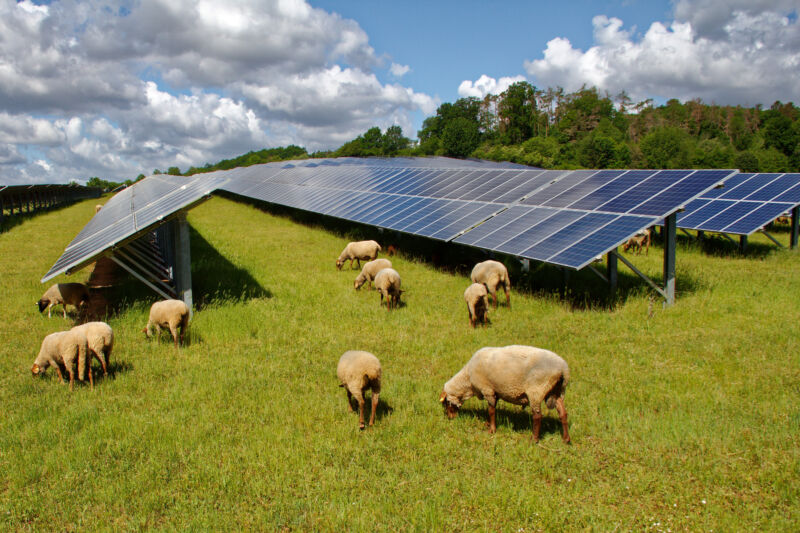
What makes a good spot for livestock and a good spot for solar farms often overlaps. They’re both large, quite flat, and get a good amount of sun, being free from tall vegetation. As such, solar producers are increasingly leasing farm land for their operations.
The increase in solar production has environmental benefits, but it can come at the price of diminished agriculture production. That’s why there’s a growing interest in finding ways of combining ag and solar production in one place. For Todd Schmit, an associate professor of agribusiness at Cornell University, this means bringing out the sheep.
It’s still a new field (Editor’s note: pun so unintended that Doug didn’t even see it until I asked), but some farmers are partnering with solar producers, the former using the latter’s land for grazing. The solar producers pay farmers to ship their sheep over to their operations, and the sheep chow down on the weeds and other plants that might grow to the point they block the Sun from reaching the panels.
The sheep get fed, the farmers get paid, and the solar producers have their vegetation managed without using mowers and weed whackers—which can sometimes struggle to reach beneath the panels and use fossil fuels—or herbicides. This industry has been expanding in New York state since 2017, according to a report by the American Solar Grazing Association (ASGA). The report notes that the Empire State currently has 900 acres of solar energy-producing land being grazed. But there’s still plenty of room to grow.
Why sheep?
Currently, not much lamb or mutton is produced in the US. According to the USDA, more than half of this meat is imported from New Zealand and Australia. As such, having sheep graze alongside solar panels could be a bit of a growth sector—and not just for meat, as sheep also produce wool and milk. Schmit noted that, although the US doesn’t currently consume much sheep’s meat, the domestic market is growing. Raising the livestock in the US could also bolster local economies.
There are a few reasons sheep are the superior choice for grazing on solar farms. For one, they are shorter than cows and horses. They will also eat most kinds of forage, which helps keep plant growth at bay. Goats, on the other hand, will chew pretty much anything, which is a bit of a risk on solar farms.
“Cows and horses are too big, so they can do damages by rubbing on the panels,” Schmit said. “Goats will eat the wires; sheep won’t. Go figure. Sheep are like the perfect medium for this.”
Sunny disposition
Recently, Schmit received $500,000 in funding (half from Cornell, the other half from the USDA) over three years. The funding is to help expand the solar-sheep practice through the creation of either a business cooperative or producer-owned organization. The project is called “A New Dawn for Shepherds: Grazing Sheep Under Utility-Scale Solar Arrays.” Schmit is partnering with various farmers, solar industry professionals, and the ASGA, which is a nonprofit organization that connects sheep farmers with solar producers. Together, they will determine what form New Dawn will take and what it will offer to farmers either hoping to expand their sheep production on solar farms or get started doing it.
The process will involve interviewing the farmers—both current and prospective—about their common needs and goals as well as their common vision for the organization. Schmit and his team will also speak with solar producers to get a sense of what they would like to see from the organization.
The form the organization will take and what it will provide are still being determined. According to Schmit, generally speaking, solar operations would rather just deal with a single entity rather than multiple farms. So the organization could be a kind of point of contact between them and the shepherds. It could also help the shepherds with contract negotiations, marketing, planning, deliveries, and logistics, among other things. However, reaching a consensus among the farmers will take some time.
“Consensus drives participation,” Schmit told Ars. “Consensus drives investment. Consensus drives more interest in the project.”
Wool they or won’t they?
(Pun completely intended that time.)
Schmit added that, although New Dawn is focused more on New York and the American Northeast, throughout the process, he and his team will be developing tools, guides, financial feasibility templates, etc., that can be used by other groups hoping to start similar organizations elsewhere. “At the end of the day, we want to be able to develop things that industries, farms, developers can use. Not everyone has to start at zero,” he said.
ASGA co-founder Lexie Hain said that the business co-op could potentially establish biosecurity protocols. If sheep from different farms mingle, they could potentially spread diseases, which is an issue that might need addressing. The organization could also potentially bargain for cheaper insurance and help suss out details around transit.
According to Hain, solar grazing is still a young field, but farmers and solar operators are becoming increasingly interested. The ASGA only formally began in 2019, but as of last February, it had 246 members, made up of various solar and sheep industry professionals. “I think there’s a lot of interest in it, and there’s a lot of potential,” she told Ars.
Article From & Read More ( When it comes to solar farms, sheep are great groundskeepers - Ars Technica )https://ift.tt/3Ea2Vh4
Bagikan Berita Ini














0 Response to "When it comes to solar farms, sheep are great groundskeepers - Ars Technica"
Post a Comment